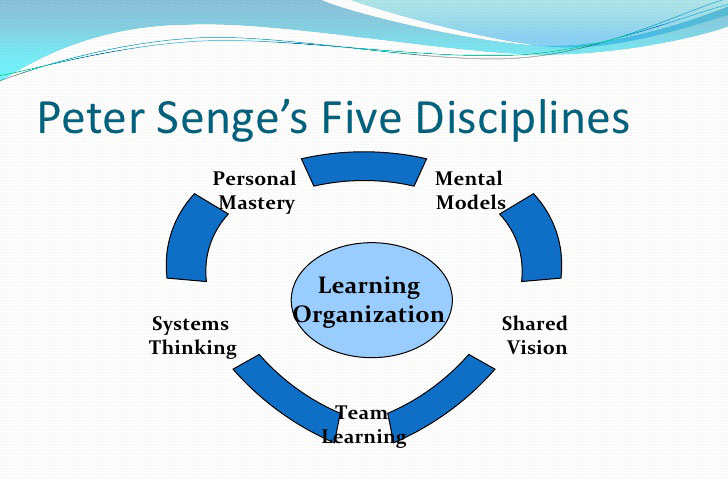The Five Disciplines of Organizational Learning
as published in The Dance of Change.

Each of the five disciplines represents a lifelong body of study and practice for individuals and teams in organizations.
1. Personal Mastery
This discipline of aspiration involves formulating a coherent picture of the results people most desire to gain as individuals (their personal vision), alongside a realistic assessment of the current state of their lives today (their current reality). Learning to cultivate the tension between vision and reality (represented in this icon by the rubber band) can expand people’s capacity to make better choices, and to achieve more of the results that they have chosen.
2. Mental Models
This discipline of reflection and inquiry skills is focused around developing awareness of the attitudes and perceptions that influence thought and interaction. By continually reflecting upon, talking about, and reconsidering these internal pictures of the world, people can gain more capability in governing their actions and decisions. The icon here portrays one of the more powerful principles of this discipline, the “ladder of inference” depicting how people leap instantly to counterproductive conclusions and assumptions.
3. Shared Vision
This collective discipline establishes a focus on mutual purpose. People learn to nourish a sense of commitment in a group or organization by developing shared images of the future they seek to create (symbolized by the eye), and the principles and guiding practices by which they hope to get there.
4. Team Learning
This is a discipline of group interaction. Through techniques like dialogue and skillful discussion, teams transform their collective thinking, learning to mobilize their energies and ability greater than the sum of individual members’ talents. The icon symbolizes the natural alignment of a learning-oriented team as the flight of a flock of birds.
5. Systems Thinking
In this discipline, people learn to better understand interdependency and change, and thereby to deal more effectively with the forces that shape the consequences of our actions. Systems thinking is based upon a growing body of theory about the behavior of feedback and complexity-the innate tendencies of a system that lead to growth or stability over time. Tools and techniques such as systems archetypes and various types of learning labs and simulations help people see how to change systems more effectively, and how to act more in tune with the larger processes of the natural and economic world. The circle in this icon represents the fundamental building block of all systems: the circular “feedback loop” underlying all growing and limiting processes in nature.
